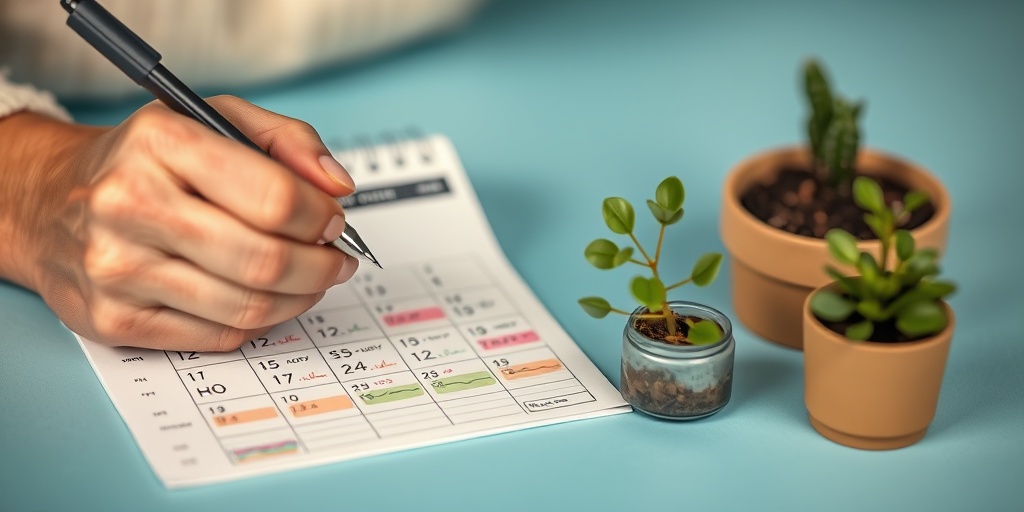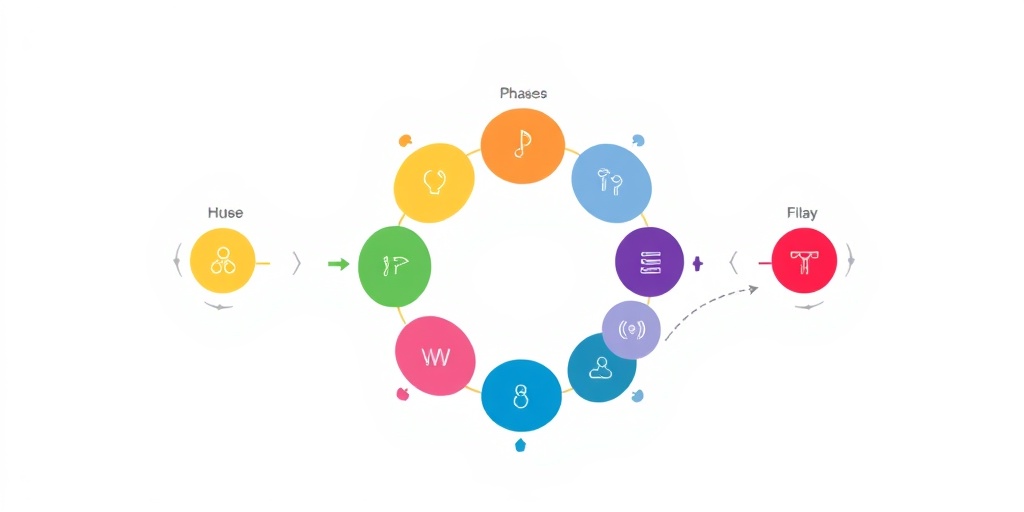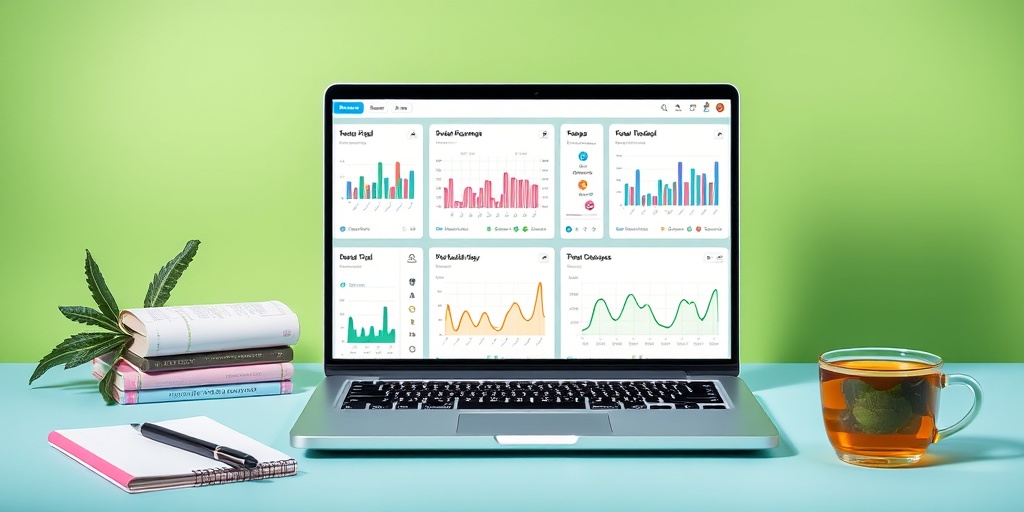What Is an Ovulation Calendar?
An ovulation calendar is a tool designed to help individuals track their menstrual cycle and identify their fertile days. This calendar is particularly useful for those trying to conceive, as it pinpoints the days when ovulation occurs, maximizing the chances of pregnancy. Understanding your ovulation cycle can also aid in family planning and managing reproductive health.
Understanding Ovulation
Ovulation is a crucial phase in the menstrual cycle, typically occurring around the midpoint of the cycle. For women with a regular 28-day cycle, ovulation usually happens around day 14. However, cycles can vary, and ovulation may occur earlier or later depending on individual factors. By using an ovulation calendar, you can gain insights into your unique cycle and better understand your body’s rhythms.
Benefits of Using an Ovulation Calendar
- Increased Awareness: Tracking your cycle helps you become more aware of your body’s signals.
- Improved Fertility Tracking: Knowing your fertile window can enhance your chances of conception.
- Cycle Regulation: It can help identify irregularities in your menstrual cycle.
- Health Monitoring: A calendar can assist in recognizing patterns that may indicate health issues.
How to Use an Ovulation Calendar
Using an ovulation calendar is straightforward, and with the right approach, you can effectively track your cycle. Here’s a step-by-step guide to help you get started:
Step 1: Know Your Cycle Length
The first step in using an ovulation calendar is to determine the length of your menstrual cycle. This is the number of days from the first day of your period to the day before your next period starts. Most cycles range from 21 to 35 days, with 28 days being the average.
Step 2: Mark Your Menstrual Cycle
Once you know your cycle length, mark the first day of your period on the calendar. This is considered day one of your cycle. Continue marking each day until your next period begins. This will help you visualize your cycle and identify patterns.
Step 3: Calculate Your Ovulation Day
To estimate your ovulation day, subtract 14 days from the total length of your cycle. For example, if you have a 28-day cycle, ovulation typically occurs around day 14. If your cycle is longer or shorter, adjust accordingly. This calculation gives you a rough estimate of when you are most fertile.
Step 4: Track Symptoms and Changes
In addition to marking your cycle, it’s beneficial to track any physical symptoms you experience, such as:
- Changes in cervical mucus: It may become clearer and stretchier around ovulation.
- Basal body temperature: A slight increase in temperature can indicate ovulation.
- Ovulation pain: Some women experience mild pain or discomfort during ovulation.
By noting these changes, you can refine your understanding of your ovulation patterns.
Step 5: Use Technology to Your Advantage
In today’s digital age, there are numerous ovulation calendar apps available that can simplify the tracking process. These apps often include features like reminders, symptom tracking, and even predictive analytics to help you identify your fertile window more accurately. Some popular options include Clue, Flo, and Ovia.
Step 6: Consult with Healthcare Professionals
If you have concerns about your menstrual cycle or fertility, consider consulting with a healthcare professional. They can provide personalized advice and may recommend additional tools or resources, such as the Yesil Health AI platform, which offers evidence-based health answers tailored to your needs.
Conclusion
Using an ovulation calendar can be a game-changer for anyone looking to understand their menstrual cycle better, whether for conception or general health monitoring. By following the steps outlined above, you can effectively track your cycle and gain valuable insights into your reproductive health. Remember, every body is unique, so take the time to learn what works best for you! 🌸

Signs of Ovulation
Understanding the signs of ovulation is crucial for anyone trying to conceive or simply wanting to track their menstrual cycle. Ovulation is the process where an ovary releases an egg, and it typically occurs midway through your cycle. Here are some common signs to look out for:
1. Changes in Cervical Mucus
One of the most noticeable signs of ovulation is a change in cervical mucus. As you approach ovulation, your body produces more estrogen, which leads to an increase in cervical mucus. This mucus becomes clear, stretchy, and resembles raw egg whites. This change helps sperm travel more easily to the egg.
2. Basal Body Temperature Rise
Your basal body temperature (BBT) is your body’s temperature at rest. Just after ovulation, there is a slight increase in BBT due to the hormone progesterone. Tracking your BBT daily can help you identify when you have ovulated. A rise of about 0.5 to 1 degree Fahrenheit can indicate that ovulation has occurred.
3. Ovulation Pain
Some women experience a sharp pain or cramping on one side of the abdomen during ovulation, known as mittelschmerz. This pain can last from a few minutes to a few hours and is a clear indicator that ovulation is taking place.
4. Increased Libido
Many women notice an increase in sexual desire around the time of ovulation. This is a natural response to the hormonal changes in your body, making it more likely for you to conceive during this fertile window.
5. Breast Tenderness
Hormonal fluctuations during ovulation can lead to breast tenderness or sensitivity. If you notice that your breasts feel fuller or more sensitive, it could be a sign that you are approaching ovulation.
6. Light Spotting
Some women may experience light spotting or bleeding around the time of ovulation. This is usually harmless and can occur as the follicle ruptures to release the egg.
Ovulation Cycle Phases
The ovulation cycle is divided into several phases, each playing a vital role in fertility and menstrual health. Understanding these phases can help you better utilize an ovulation calendar to track your cycle effectively.
1. Follicular Phase
The follicular phase begins on the first day of your period and lasts until ovulation. During this phase, the pituitary gland releases follicle-stimulating hormone (FSH), which stimulates the growth of ovarian follicles. As the follicles mature, they produce estrogen, which helps thicken the uterine lining in preparation for a potential pregnancy.
2. Ovulation Phase
Ovulation typically occurs around the midpoint of your cycle, usually 14 days before your next period starts. A surge in luteinizing hormone (LH) triggers the release of a mature egg from the ovary. This is the most fertile time in your cycle, and tracking this phase with an ovulation calendar calculator can significantly increase your chances of conception.
3. Luteal Phase
After ovulation, the luteal phase begins. The ruptured follicle transforms into the corpus luteum, which produces progesterone. This hormone helps maintain the uterine lining for a potential pregnancy. If fertilization does not occur, the corpus luteum disintegrates, leading to a drop in progesterone levels and the eventual onset of menstruation.
4. Menstrual Phase
The menstrual phase marks the beginning of a new cycle. If the egg is not fertilized, the thickened uterine lining sheds, resulting in menstruation. This phase typically lasts between 3 to 7 days, after which the cycle starts anew.
By understanding these phases and recognizing the signs of ovulation, you can effectively use an ovulation calendar to monitor your cycle, whether you’re trying to conceive or simply want to gain insight into your reproductive health. 🌸

Factors Affecting Ovulation
Understanding the factors that affect ovulation is crucial for anyone trying to conceive or simply wanting to track their menstrual cycle. Ovulation is a complex process influenced by various elements, including hormonal balance, lifestyle choices, and underlying health conditions. Let’s explore these factors in detail.
1. Hormonal Balance
The menstrual cycle is regulated by a delicate interplay of hormones, primarily estrogen and progesterone. Any disruption in these hormones can lead to irregular ovulation or even anovulation (the absence of ovulation). Conditions such as polycystic ovary syndrome (PCOS) and thyroid disorders can significantly impact hormonal levels, making it essential to monitor these factors if you’re using an ovulation calendar.
2. Age
Age plays a significant role in fertility and ovulation. Women are born with a finite number of eggs, and as they age, the quantity and quality of these eggs decline. Typically, ovulation becomes less regular in the late 30s and early 40s, which can affect the accuracy of an ovulation calendar. Understanding your age-related fertility can help you plan better.
3. Lifestyle Choices
Your daily habits can also influence ovulation. Factors such as:
- Diet: A balanced diet rich in vitamins and minerals supports hormonal health.
- Exercise: Regular physical activity can help maintain a healthy weight, which is crucial for regular ovulation.
- Stress: High-stress levels can disrupt hormonal balance, leading to irregular cycles.
- Sleep: Quality sleep is essential for hormonal regulation.
Making positive lifestyle changes can enhance your chances of regular ovulation and improve overall reproductive health.
4. Medical Conditions
Several medical conditions can affect ovulation. For instance:
- Polycystic Ovary Syndrome (PCOS): This common condition can lead to irregular periods and ovulation.
- Endometriosis: This disorder can cause pain and affect the ovaries, leading to ovulation issues.
- Thyroid Disorders: Both hyperthyroidism and hypothyroidism can disrupt the menstrual cycle.
If you suspect that a medical condition is affecting your ovulation, consulting a healthcare provider is essential for proper diagnosis and treatment.
5. Medications
Certain medications can also impact ovulation. For example, hormonal contraceptives prevent ovulation altogether, while other medications may have side effects that disrupt hormonal balance. If you’re trying to conceive, it’s important to discuss any medications you’re taking with your doctor to understand their potential effects on your ovulation.
Ovulation Calendar Apps
In today’s digital age, tracking your ovulation has never been easier, thanks to various ovulation calendar apps. These apps can help you monitor your menstrual cycle, predict ovulation, and even track symptoms related to your cycle. Here’s a look at some popular features and benefits of using these apps.
1. User-Friendly Interface
Most ovulation calendar apps are designed with user experience in mind. They often feature intuitive interfaces that allow you to input your cycle data easily. Whether you have a regular cycle or one that varies, these apps can adapt to your needs.
2. Cycle Tracking
One of the primary functions of an ovulation calendar app is to track your menstrual cycle. By inputting the start and end dates of your period, the app can predict your ovulation window, helping you identify your most fertile days. This is particularly useful for those using an ovulation calendar for a 28-day cycle or those looking for an ovulation calendar example to guide them.
3. Symptom Logging
Many apps allow you to log symptoms such as mood changes, physical discomfort, and other menstrual cycle-related experiences. This feature can help you identify patterns over time, making it easier to understand your body’s unique rhythm.
4. Notifications and Reminders
To ensure you don’t miss your fertile window, many ovulation calendar apps offer notifications and reminders. These alerts can help you stay on track with your cycle and optimize your chances of conception.
5. Community Support
Some apps also provide access to community forums where users can share experiences, tips, and advice. This can be particularly beneficial for those navigating fertility challenges or seeking support from others on a similar journey.
In conclusion, understanding the factors affecting ovulation and utilizing ovulation calendar apps can empower you to take control of your reproductive health. Whether you’re trying to conceive or simply want to track your cycle, these tools can provide valuable insights and support. 🌸

Benefits of Tracking Ovulation
Understanding your menstrual cycle is crucial for various reasons, and one of the most effective ways to do this is by using an ovulation calendar. This tool not only helps in family planning but also provides insights into your overall reproductive health. Here are some key benefits of tracking ovulation:
1. Enhanced Family Planning
For couples trying to conceive, knowing when ovulation occurs is vital. An ovulation calendar can help pinpoint the most fertile days, increasing the chances of conception. By tracking your cycle, you can identify patterns and predict ovulation with greater accuracy.
2. Understanding Your Menstrual Cycle
Using an ovulation calendar allows you to gain a deeper understanding of your menstrual cycle. This knowledge can help you recognize any irregularities, which may indicate underlying health issues. Regular tracking can also help you anticipate your period, making it easier to plan your activities.
3. Identifying Fertility Issues
If you’ve been trying to conceive for a while without success, an ovulation calendar can be a valuable tool in identifying potential fertility issues. By tracking ovulation, you can determine if you are ovulating regularly or if there are any irregularities that may require medical attention.
4. Hormonal Health Insights
Tracking ovulation can provide insights into your hormonal health. Changes in your cycle can indicate hormonal imbalances, which may affect your overall health. An ovulation calendar can help you monitor these changes and discuss them with your healthcare provider.
5. Natural Birth Control Method
For those looking to avoid pregnancy, an ovulation calendar can serve as a natural birth control method. By understanding your fertile window, you can make informed decisions about sexual activity during those days. However, it’s essential to note that this method requires diligence and may not be as reliable as other contraceptive methods.
6. Empowerment and Education
Tracking your ovulation empowers you with knowledge about your body. It encourages you to take an active role in your reproductive health, leading to better health decisions. An ovulation calendar can also serve as a conversation starter with your healthcare provider, allowing for more informed discussions about your health.
Common Myths About Ovulation
Despite the wealth of information available, many myths about ovulation persist. Understanding these misconceptions can help you make informed decisions about your reproductive health. Here are some common myths debunked:
1. Ovulation Only Happens Once a Month
Many people believe that ovulation occurs only once during the menstrual cycle. While it is true that ovulation typically happens once per cycle, some women may experience multiple ovulations in a single cycle, especially if they have irregular cycles. Tracking with an ovulation calendar can help clarify this.
2. You Can’t Get Pregnant During Your Period
Another common myth is that you cannot conceive during your period. While the chances are lower, sperm can survive in the female reproductive tract for up to five days. If you have a shorter cycle, it’s possible to ovulate shortly after your period ends, making it feasible to conceive during menstruation.
3. Ovulation Symptoms Are the Same for Everyone
Many believe that ovulation symptoms, such as cramping or changes in cervical mucus, are universal. In reality, every woman experiences ovulation differently. Some may have noticeable symptoms, while others may not feel anything at all. An ovulation calendar can help you identify your unique signs.
4. Birth Control Regulates Ovulation
While hormonal birth control can regulate your cycle, it does not necessarily mean you are ovulating. In fact, many forms of birth control suppress ovulation altogether. If you’re looking to understand your natural cycle, it’s essential to track ovulation after discontinuing birth control.
5. Ovulation Is Always Predictable
Many assume that ovulation occurs on the same day every month. However, various factors, including stress, illness, and lifestyle changes, can affect the timing of ovulation. Using an ovulation calendar can help you track these variations and better understand your cycle.
By debunking these myths and understanding the benefits of tracking ovulation, you can take charge of your reproductive health and make informed decisions about your body. 🌸

Frequently Asked Questions about Ovulation Calendar
What is an Ovulation Calendar?
An ovulation calendar is a tool that helps track a woman’s menstrual cycle to predict ovulation days. By understanding when ovulation occurs, women can better plan for conception or avoid pregnancy.
How do I use an Ovulation Calendar?
To use an ovulation calendar, you need to know the length of your menstrual cycle. Mark the first day of your period and count the days until your next period starts. Ovulation typically occurs about 14 days before your next period. You can use this information to identify your fertile window.
Can I find a free Ovulation Calendar?
Yes! There are many free ovulation calendar tools available online. These can help you track your cycle and predict ovulation without any cost. Look for reputable health websites or apps that offer this feature.
Is there an Ovulation Calendar app?
Absolutely! There are several ovulation calendar apps available for smartphones. These apps often provide additional features such as reminders, cycle tracking, and personalized insights based on your data.
What if my cycle is irregular?
If you have an irregular cycle, using an ovulation calendar may be more challenging. It’s advisable to track your cycles over several months to identify patterns. You might also consider consulting a healthcare provider for personalized advice.
Can an Ovulation Calendar help me conceive a baby boy?
Some believe that timing intercourse around ovulation can influence the sex of the baby. An ovulation calendar for baby boy suggests having intercourse on the day of ovulation or the day before. However, there is no scientific guarantee of this method.
What is an Ovulation Calendar Chart?
An ovulation calendar chart visually represents your menstrual cycle, showing the days of your period, ovulation, and fertile window. This chart can help you quickly identify patterns and predict future cycles.
Where can I find an Ovulation Calendar example?
You can find various ovulation calendar examples online. Many health websites provide templates that you can print or use digitally to track your cycle effectively.
How accurate is an Ovulation Calendar?
The accuracy of an ovulation calendar depends on how consistently you track your cycle. For women with regular cycles, it can be quite accurate. However, factors like stress, illness, and hormonal changes can affect ovulation timing.
Can I use an Ovulation Calendar with other fertility tracking methods?
Yes! An ovulation calendar can be used alongside other fertility tracking methods, such as basal body temperature monitoring or ovulation predictor kits, to enhance your understanding of your cycle and fertility.



